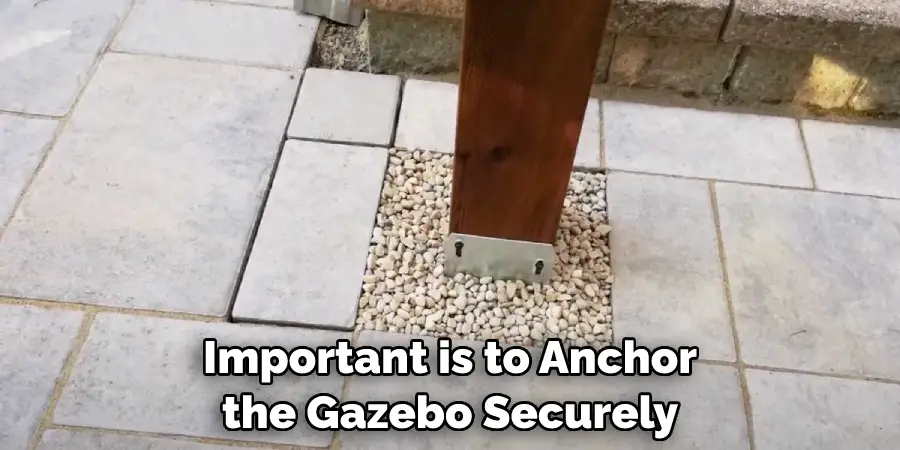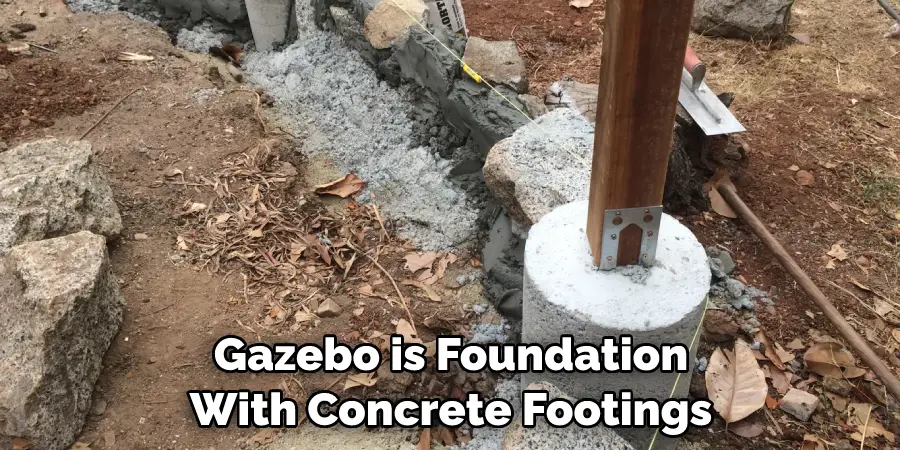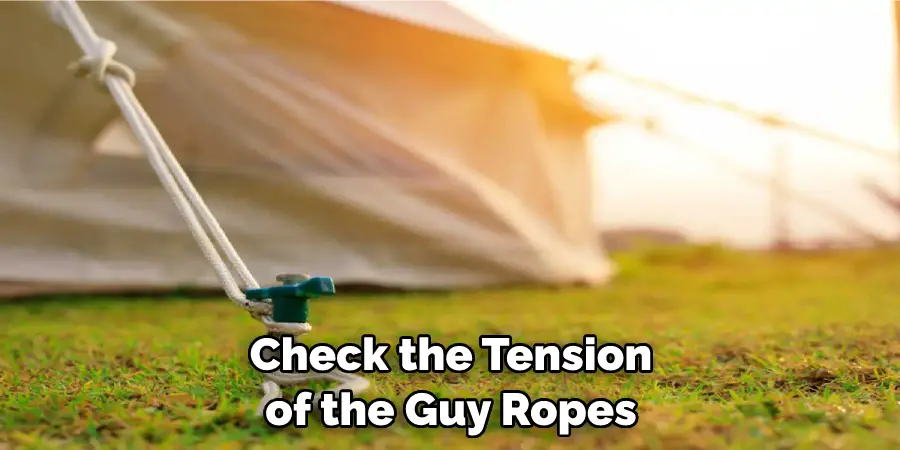Amidst the tranquil beauty of an outdoor gazebo, the formidable force of the wind can pose a significant challenge, threatening to mar the serenity of your oasis. In this comprehensive guide, we explore the art and science of safeguarding your gazebo against the relentless embrace of wind. As nature’s unseen dancer, wind can be tamed through strategic planning and skillful execution.

Whether you’re nestled in a coastal retreat or surrounded by open landscapes, understanding the intricacies of securing a gazebo from wind is paramount. From selecting wind-resistant materials and anchoring techniques to implementing design considerations that harness the power of aerodynamics, we delve into a range of methods on how to secure a gazebo from wind, even in the face of nature’s most powerful rhythms.
Importance of Securing Gazebos against Wind
Wind can be a powerful force, and knowing how to secure your gazebo against it is vital for protecting both the structure of your gazebo as well as the safety of those within it. Without proper preparation, wind can cause tremendous damage and even endanger lives.
To protect your gazebo from the damaging effects of wind, there are several measures you can take. The most important is to anchor the gazebo securely, using stakes or weights in all four corners of the structure. This will help prevent the entire gazebo from being lifted by strong winds and thrown across the landscape.
In addition, it’s a good idea to use wind-resistant materials for your gazebo. Heavy-duty canvas or polyester fabric can provide extra protection against the wind, as can metal or plastic tarps and reinforced walls.
Of course, make sure to choose materials that are light enough to be safely lifted by you but strong enough to hold up under the pressure of high winds.
Finally, if your gazebo is in an area that experiences strong winds, it’s best to keep it unoccupied during these times. That way you can be sure nobody’s safety will be put at risk and the structure of the gazebo won’t suffer any damage.

Potential Risks and Damages Caused by Strong Winds
Strong winds can cause serious damage to a gazebo if it is not secured adequately. The most common risks associated with strong winds and unsecured gazebos are the following:
- Uprooting of posts from their base or brackets
- Damage to the roof of the gazebo due to the wind slamming against it
- Collapse of the gazebo if wind gusts are strong enough to overpower its structural integrity
- Debris from nearby objects being kicked up against the gazebo, causing damage to it.
Having a secure gazebo can help protect both your property and your family’s safety – so taking steps to make sure that it is securely fixed down is essential.
11 Steps How to Secure a Gazebo from Wind
Step 1: Deliberate Location Selection
The foundation of a wind-resistant gazebo begins with the sagacious choice of its location. Seek an area shielded from prevailing winds, utilizing natural barriers such as nearby structures, trees, or topographical features. This thoughtful positioning not only mitigates direct wind impact but also fosters a harmonious integration of your gazebo within the landscape.
Step 2: Materials Engineered for Endurance
The elemental composition of your gazebo plays a pivotal role in its capacity to withstand wind. Opt for materials renowned for their sturdiness, such as pressure-treated wood, durable metals, or advanced composite materials. A judicious material selection lays the groundwork for a gazebo that can withstand wind’s unyielding forces.
Step 3: Architectural Ingenuity and Wind-Resistant Designs
Embark on your gazebo installation journey armed with architectural designs specifically crafted to combat wind. Embrace designs that incorporate wind-resistant features like aerodynamic rooflines, and robust joints. These structural innovations elevate your gazebo’s wind resilience to an art form.
Step 4: Anchoring with Tenacity
Anchor your gazebo steadfastly to the earth, thwarting wind’s attempts to dislodge it. Employ ground anchors or auger-style stakes driven deep into the soil, attaching them securely to the gazebo’s base. This method not only confers stability but also harnesses the principles of tension to withstand lateral wind forces.
Step 5: Fortified Foundation with Concrete Footings
For unparalleled stability, augment your gazebo’s foundation with concrete footings. These subterranean pillars offer a robust base, effectively resisting wind-induced lifting and movement. Ensure the footings extend below the frost line to circumvent upheaval caused by freeze-thaw cycles.

Step 6: Guy Lines and Tension Techniques
Implement a network of guy lines that extend from strategic points on your gazebo to anchor points in the ground. These tautly stretched lines act as resilient barriers, dissipating wind energy and averting excessive swaying. Achieve a harmonious balance between tension and flexibility to allow controlled movement.
Step 7: Vigilant Roof and Canopy Reinforcement
The gazebo’s roof and canopy are primary targets for wind’s assault. Bolster their resilience by securely fastening roof panels or canopy fabric to the frame. Incorporate robust hardware and meticulous installation techniques, effectively reducing the risk of detachment or damage during gusty conditions.
Step 8: Integrate Natural Windbreaks
Enhance your gazebo’s wind resilience through the strategic placement of natural windbreaks. Cultivate wind-resistant vegetation, erect trellises with climbing plants, or install decorative screens. These windbreaks preemptively diffuse wind’s intensity, creating a microenvironment of diminished turbulence.
Step 9: Consistent Maintenance Regimen
Cultivate a regime of regular maintenance and vigilant inspections. Routinely assess your gazebo for signs of wear, loose connections, or compromised structural elements. Swiftly address any identified issues, ensuring the gazebo’s continual robustness against wind’s persistent challenges.
Step 10: Weather Vigilance and Proactive Measures
Remain attuned to weather forecasts and predictions, especially during periods of anticipated high winds. Take proactive measures such as removing canopy fabric or securing loose components before the wind’s arrival. By preemptively minimizing exposure, you mitigate potential wind-induced vulnerabilities.
Step 11: Advanced Engineering and Wind Tunnel Testing
Consider engaging in advanced engineering techniques, such as wind tunnel testing, to optimize your gazebo’s wind resistance. Collaborate with professionals to assess and enhance your gazebo’s structural integrity, validating its performance against varying wind speeds and directions.

Factors Affecting Wind Behavior around Gazebos
Wind behavior can be unpredictable and highly variable, often changing direction and speed suddenly and with little warning. When considering how to secure a gazebo from wind, it is important to understand the various environmental factors that influence the behavior of wind around your structure. These factors include:
- Terrain: The type of terrain surrounding your gazebo will have a direct effect on the strength and direction of the wind. Sloping terrain can create what is known as an “air cushion” that deflects wind away from your gazebo, while flat land will typically allow winds to move unimpeded.
- Vegetation: Plants and trees can help break up gusts of wind before they reach your gazebo. Even if you don’t have a lot of greenery, adding a few bushes or shrubs can help cut down on the wind’s power as it passes by.
- Buildings: Any nearby buildings will create their own “air cushion” that can alter the flow of wind around your gazebo. Pay attention to any nearby buildings and adjust your gazebo accordingly.
Things to Consider When Securing from Wind
If you are setting up a gazebo in your backyard, then you need to take the wind into consideration when securing it. Here are some of the important things you should think about:
- Stakes and Sandbags: You will need to drive stakes into the ground around the perimeter or secure sand bags to keep the gazebo from moving.
- Guy Lines: Attaching guy lines to the outer corners of your gazebo can provide extra support and keep it stable against strong wind gusts.
- Weights: If you don’t have stakes or sandbags available, you can use some weights such as bricks or heavy stones to secure the gazebo in place.
- Anchoring: If you have a larger gazebo, then it may be beneficial to anchor it into the ground for more stability. This is especially important in areas with high winds.
- Guy Ropes and Lines: Make sure that all guy ropes and lines are securely tied off to prevent them from coming loose during high winds.
Some Common Mistakes to Avoid When Securing a Gazebo from Wind
When securing a gazebo from wind, there are some common mistakes that you should avoid in order to maximize its safety and stability.
First of all, make sure not to skip the anchoring process.
Anchoring your gazebo is important for two reasons: it helps hold the structure down even during strong gusts of wind, and it also provides protection against theft. Secure the anchors into the ground so that they are secure and fixed in place.
Another common mistake to avoid is using old or unsuitable materials for anchoring the gazebo. Make sure to use a material that can withstand strong winds and provide optimal stability to your gazebo.
Thirdly, do not forget to check the tension of the guy ropes. Guy ropes are essential for providing extra stability against strong winds and should be adjusted so that they provide maximum support.

Finally, make sure to double-check all parts of your gazebo after securing it with anchors and guy ropes. This will help ensure your gazebo is safe and secure, even during strong gusts of wind.
Conclusion
In conclusion, learning how to secure a gazebo from wind can be pretty straightforward, especially if you follow the steps outlined here. There are a variety of ways to tailor the approach for the particular needs of protecting your gazebo from windy weather.
From anchoring it into the ground with stakes to adding extra webbing and ratchets to even reinforcing it with sandbags, there doesn’t seem to be a one-size-fits-all solution that works for every kind of gazebo out there.
No matter which option you choose though, make sure to spend time researching what might work best for your situation so you can ensure that once secured, your gazebo won’t be moved or damaged by windy conditions!
About
Outdoor Fixes is a distinguished figure in the world of Diy design, with a decade of expertise creating innovative and sustainable Diy solutions.
His professional focus lies in merging traditional craftsmanship with modern manufacturing techniques,
fostering designs that are both practical and environmentally conscious. As the author of diy,
outdoorfixes delves into the art and science of outdoorfixes-making, inspiring artisans and industry professionals alike.
Education RMIT University
(Melbourne, Australia) Associate Degree in Design (Outdoor Fixes) Focus on sustainable design, industry-driven projects,
and practical craftsmanship. Gained hands-on experience with traditional and digital manufacturing tools, such as CAD and CNC software.
Nottingham Trent University
(United Kingdom) Bachelor’s in outdoorfixes.com and Product Design (Honors) Specialized in product design with a focus on blending creativity with production
techniques. Participated in industry projects, working with companies like John Lewis and Vitsoe to gain real-world insights.
Publications and Impact
In diy, Outdoor Fixes his insights on indoor design processes, materials, and strategies for efficient production.
His writing bridges the gap between artisan knowledge and modern industry needs, making it a must-read for both budding designers and seasoned professionals.

